 |
 |
|
 |
|
 |
|  |
|  |
|
 |
|
 |
|  |
|  |
|
 |
"Mr" <m******r******at_hotmail_dot_fr> wrote:
> "And" <49341109@ntnu.edu.tw> wrote:
> > "And" <49341109@ntnu.edu.tw> wrote:
> > > I will post some pictures in the following days. Not very high grade,but
> > > has reached a stage.
> >
> > The basic idea here..
>
> All of these results are awesome !
Thanks. I'm trying to generate small speckles.
It is an emphasis, too.
And I'm thinking how composite this to the base color. I use "average" in this
picture. But this method is fail to more requirements. Sometimes speckles should
darker than the base color. the method cannot control it well.
Post a reply to this message
Attachments:
Download 'show tree function test bumps t y15 - y60.png' (900 KB)
Preview of image 'show tree function test bumps t y15 - y60.png'

|
 |
|  |
|  |
|
 |
|
 |
|  |
|  |
|
 |
"And" <49341109@ntnu.edu.tw> wrote:
> Thanks. I'm trying to generate small speckles.
>
> It is an emphasis, too.
>
> And I'm thinking how composite this to the base color. I use "average" in this
> picture. But this method is fail to more requirements. Sometimes speckles should
> darker than the base color. the method cannot control it well.
I think that this is going to be another advanced-granite texture odyssey.
You will probably need to use functions, and some way to introduce noise, in
order to randomize those color variations in the growth rings.
If you're going to tackle that, I'd probably start by making a list of common
features of real wood, and think about how to implement each of those, and where
they need to be in a hierarchy.
Different growth ring thicknesses. (one ring vs another)
Variable growth ring thickness (change in thickness along any given ring)
Asymmetric growth ring thickness. (a bent or curved branch will be thick on one
side and thin on the other)
Alternating light-dark / thick-thin growth rings
Darkening along a localized group of rings due to mold/fungus, etc.
Holes due to boring insects
"checking" (cracks) due to splitting when cut wood is rapidly dried
a more granular texture for the rings to represent the fibrous nature of the
wood.
SSLT
Diagrams or photos of wood would likely help you envision the types of functions
that would control each of those attributes, and suggest ways to combine them
into a final overall texture/material.
There are all of the different ways to cut wood to get different grain patterns
and expansion/contraction behaviour.
Then there's the fun of formulating pigment/texture maps for all of the
different species... ;)
Post a reply to this message
|
 |
|  |
|  |
|
 |
|
 |
|  |
|  |
|
 |
"Bald Eagle" <cre### [at] netscape net> wrote:
> "And" <49341109@ntnu.edu.tw> wrote:
>
> > Thanks. I'm trying to generate small speckles.
> >
> > It is an emphasis, too.
> >
> > And I'm thinking how composite this to the base color. I use "average" in this
> > picture. But this method is fail to more requirements. Sometimes speckles should
> > darker than the base color. the method cannot control it well.
>
> I think that this is going to be another advanced-granite texture odyssey.
>
> You will probably need to use functions, and some way to introduce noise, in
> order to randomize those color variations in the growth rings.
>
I always use functions, till the pigment composite.
> If you're going to tackle that, I'd probably start by making a list of common
> features of real wood, and think about how to implement each of those, and where
> they need to be in a hierarchy.
Yes, I'm dealing with it.
>
> Different growth ring thicknesses. (one ring vs another)
It has done, notice the program manipulate video 0:12 ~ 0:29, it control the
radial growth speed vs year.
Than program output the year_vs_r function using select(r - r0, , ...),
than composite them to time_function(x, y, z) with angular distortion.
> Variable growth ring thickness (change in thickness along any given ring)
This is a good idea, I think I should add it.
> Asymmetric growth ring thickness. (a bent or curved branch will be thick on one
> side and thin on the other)
Not uniform ring thickness I wonder how to implement. Basically, if it can
implement in POV-Ray, than it can do in principle. My Java program can output
some data and it can be numerous like the attachment. net> wrote:
> "And" <49341109@ntnu.edu.tw> wrote:
>
> > Thanks. I'm trying to generate small speckles.
> >
> > It is an emphasis, too.
> >
> > And I'm thinking how composite this to the base color. I use "average" in this
> > picture. But this method is fail to more requirements. Sometimes speckles should
> > darker than the base color. the method cannot control it well.
>
> I think that this is going to be another advanced-granite texture odyssey.
>
> You will probably need to use functions, and some way to introduce noise, in
> order to randomize those color variations in the growth rings.
>
I always use functions, till the pigment composite.
> If you're going to tackle that, I'd probably start by making a list of common
> features of real wood, and think about how to implement each of those, and where
> they need to be in a hierarchy.
Yes, I'm dealing with it.
>
> Different growth ring thicknesses. (one ring vs another)
It has done, notice the program manipulate video 0:12 ~ 0:29, it control the
radial growth speed vs year.
Than program output the year_vs_r function using select(r - r0, , ...),
than composite them to time_function(x, y, z) with angular distortion.
> Variable growth ring thickness (change in thickness along any given ring)
This is a good idea, I think I should add it.
> Asymmetric growth ring thickness. (a bent or curved branch will be thick on one
> side and thin on the other)
Not uniform ring thickness I wonder how to implement. Basically, if it can
implement in POV-Ray, than it can do in principle. My Java program can output
some data and it can be numerous like the attachment.
Post a reply to this message
Attachments:
Download 'style.png' (87 KB)
Preview of image 'style.png'
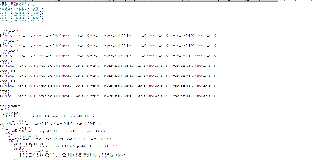
|
 |
|  |
|  |
|
 |
|
 |
|  |
|  |
|
 |
"Bald Eagle" <cre### [at] netscape net> wrote:
> Alternating light-dark / thick-thin growth rings
I'm not sure. Is this the previous item I reply but I interpret your meaning
wrong?
> Darkening along a localized group of rings due to mold/fungus, etc.
I think it shoud contain this, too. But wait until I solve every situation I
encounter.
> Holes due to boring insects
> "checking" (cracks) due to splitting when cut wood is rapidly dried
Are you a professional person? Maybe we can discuss it. I don't know so much
about it.
> a more granular texture for the rings to represent the fibrous nature of the
> wood.
It will be competent, I'm thinking how to do this, too.
> SSLT
I'm not make efforts for the POV-Ray render. I only do the texture in POV-Ray
than I want to output the (maybe UV-map) image to another program. It can form
the pigment, ... at least.
>
> Diagrams or photos of wood would likely help you envision the types of functions
> that would control each of those attributes, and suggest ways to combine them
> into a final overall texture/material.
> There are all of the different ways to cut wood to get different grain patterns
> and expansion/contraction behaviour.
I need realize this, too.
>
> Then there's the fun of formulating pigment/texture maps for all of the
> different species... ;)
My living country don't have much ... oak, pine ..., which species I see in the
book. (Not the same)
I'm not very familiar with these. net> wrote:
> Alternating light-dark / thick-thin growth rings
I'm not sure. Is this the previous item I reply but I interpret your meaning
wrong?
> Darkening along a localized group of rings due to mold/fungus, etc.
I think it shoud contain this, too. But wait until I solve every situation I
encounter.
> Holes due to boring insects
> "checking" (cracks) due to splitting when cut wood is rapidly dried
Are you a professional person? Maybe we can discuss it. I don't know so much
about it.
> a more granular texture for the rings to represent the fibrous nature of the
> wood.
It will be competent, I'm thinking how to do this, too.
> SSLT
I'm not make efforts for the POV-Ray render. I only do the texture in POV-Ray
than I want to output the (maybe UV-map) image to another program. It can form
the pigment, ... at least.
>
> Diagrams or photos of wood would likely help you envision the types of functions
> that would control each of those attributes, and suggest ways to combine them
> into a final overall texture/material.
> There are all of the different ways to cut wood to get different grain patterns
> and expansion/contraction behaviour.
I need realize this, too.
>
> Then there's the fun of formulating pigment/texture maps for all of the
> different species... ;)
My living country don't have much ... oak, pine ..., which species I see in the
book. (Not the same)
I'm not very familiar with these.
Post a reply to this message
|
 |
|  |
|  |
|
 |
|
 |
|  |
|  |
|
 |
"And" <49341109@ntnu.edu.tw> wrote:
> > Asymmetric growth ring thickness. (a bent or curved branch will be thick on one
> > side and thin on the other)
>
> Not uniform ring thickness I wonder how to implement. Basically, if it can
> implement in POV-Ray, than it can do in principle. My Java program can output
> some data and it can be numerous like the attachment.
You could just an angle value to multiply the radius or thickness by.
use atan2, and make sure the output of the function varies from 0 to 1 from one
side of the unit circle to the other. then multioply by some amount of bend and
then add 1, to get a range from 1 to N.
If you know how to do things like geometric inversion, you could use that to
distort the cylinder like a torus is distorted into a Dupin cylide.
There may be other ways as well.
Post a reply to this message
|
 |
|  |
|  |
|
 |
|
 |
|  |
|  |
|
 |
"And" <49341109@ntnu.edu.tw> wrote:
> "Bald Eagle" <cre### [at] netscape net> wrote:
>
> > Alternating light-dark / thick-thin growth rings
>
> I'm not sure. Is this the previous item I reply but I interpret your meaning
> wrong?
I think there are several aspects of tree rings that are all sort of
interrelated.
https://www.theforestacademy.com/tree-knowledge/annual-growth-rings/
When you abrade wood, erode it - like with driftwood, or stain it, you get an
enhancement of the grain. This is due to the alternating hard/soft regions, and
usually the soft regions are light, and the harder regions are more brown.
Maybe xylem and phloem?
> > Holes due to boring insects
> > "checking" (cracks) due to splitting when cut wood is rapidly dried
>
> Are you a professional person? Maybe we can discuss it. I don't know so much
> about it.
I don't do anything with wood for a living, but I've felled, sawn, and worked
with lots of different wood. And made plenty of mistakes.
https://blog.spib.org/shakes-checks-and-splits-in-dimension-lumber/
https://thetoolscout.com/how-to-dry-wood-fast-for-woodworking/
> > Then there's the fun of formulating pigment/texture maps for all of the
> > different species... ;)
>
> My living country don't have much ... oak, pine ..., which species I see in the
> book. (Not the same)
> I'm not very familiar with these.
Thankfully there are now millions of images that you can search to see what any
types of wood look like, and all of the variations and defects, some of whick
are highly sought after - liked spalted wood. net> wrote:
>
> > Alternating light-dark / thick-thin growth rings
>
> I'm not sure. Is this the previous item I reply but I interpret your meaning
> wrong?
I think there are several aspects of tree rings that are all sort of
interrelated.
https://www.theforestacademy.com/tree-knowledge/annual-growth-rings/
When you abrade wood, erode it - like with driftwood, or stain it, you get an
enhancement of the grain. This is due to the alternating hard/soft regions, and
usually the soft regions are light, and the harder regions are more brown.
Maybe xylem and phloem?
> > Holes due to boring insects
> > "checking" (cracks) due to splitting when cut wood is rapidly dried
>
> Are you a professional person? Maybe we can discuss it. I don't know so much
> about it.
I don't do anything with wood for a living, but I've felled, sawn, and worked
with lots of different wood. And made plenty of mistakes.
https://blog.spib.org/shakes-checks-and-splits-in-dimension-lumber/
https://thetoolscout.com/how-to-dry-wood-fast-for-woodworking/
> > Then there's the fun of formulating pigment/texture maps for all of the
> > different species... ;)
>
> My living country don't have much ... oak, pine ..., which species I see in the
> book. (Not the same)
> I'm not very familiar with these.
Thankfully there are now millions of images that you can search to see what any
types of wood look like, and all of the variations and defects, some of whick
are highly sought after - liked spalted wood.
Post a reply to this message
|
 |
|  |
|  |
|
 |
|
 |
|  |
|  |
|
 |
Browse your links roughly. Thank you.
Careless reading because I still effort on existed plane.
This one I cancelled the vertical pattern because it looks artifact.
And I try using several pattern (vs different age) superposition , because I
would like maintain the fiber length at different position.
This one about 0.1m.
Post a reply to this message
Attachments:
Download 'show tree function test several f with bumps l0.10.png' (813 KB)
Preview of image 'show tree function test several f with bumps l0.10.png'
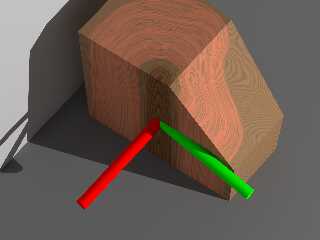
|
 |
|  |
|  |
|
 |
|
 |
|  |
|  |
|
 |
And this one about 0.01m.
With some artifact during the position it shows staggered.
I should think a better method.
Post a reply to this message
Attachments:
Download 'show tree function test several f with bumps l0.01.png' (863 KB)
Preview of image 'show tree function test several f with bumps l0.01.png'
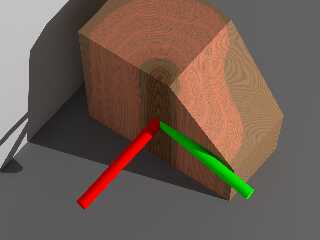
|
 |
|  |
|  |
|
 |
|
 |
|  |
|  |
|
 |
I'm satisfied with this one, but with heavier coverage it is not so natural.
And variety for the height is a problem (I cancelled the original form, the new
one is list-to-do).
I found pigment_map should be a better method to composite the base color with
the thin fiber. Thus the fiber can be a darker color than the base. I still use
the 'average', but I will rewrite it.
If the output pigment want to maintain the fiber length, wood heart is another
challenge, I have tried some method, but no perfect one.
Post a reply to this message
Attachments:
Download 'show tree function test bumps l0.01 thickness0.07year near.png' (1759 KB)
Preview of image 'show tree function test bumps l0.01 thickness0.07year near.png'
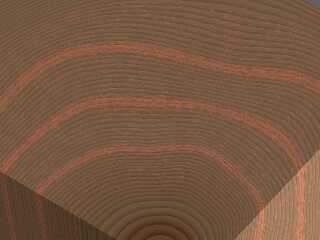
|
 |
|  |
|  |
|
 |
|
 |
|  |
|  |
|
 |
"Bald Eagle" <cre### [at] netscape net> wrote:
> "And" <49341109@ntnu.edu.tw> wrote:
> > "Bald Eagle" <cre### [at] netscape net> wrote:
> "And" <49341109@ntnu.edu.tw> wrote:
> > "Bald Eagle" <cre### [at] netscape net> wrote:
> When you abrade wood, erode it - like with driftwood, or stain it, you get an
> enhancement of the grain. This is due to the alternating hard/soft regions, and
> usually the soft regions are light, and the harder regions are more brown.
Thanks for this knowledge.
>
> > > Holes due to boring insects
> > > "checking" (cracks) due to splitting when cut wood is rapidly dried
> >
> > Are you a professional person? Maybe we can discuss it. I don't know so much
> > about it.
>
> I don't do anything with wood for a living, but I've felled, sawn, and worked
> with lots of different wood. And made plenty of mistakes.
Here is no chance to fell a tree, not to mention I'm living in a city. Such a
thing is secluded to me, so I have respect to the people who can do these
things.
> > > Then there's the fun of formulating pigment/texture maps for all of the
> > > different species... ;)
That's right, I will use pigment_map, but this is a picture I rendered, improved
the defect yesterday, and this is a two layered(in fact average of two) pattern
with different fiber length, eliminate some artifact about the coherence. net> wrote:
> When you abrade wood, erode it - like with driftwood, or stain it, you get an
> enhancement of the grain. This is due to the alternating hard/soft regions, and
> usually the soft regions are light, and the harder regions are more brown.
Thanks for this knowledge.
>
> > > Holes due to boring insects
> > > "checking" (cracks) due to splitting when cut wood is rapidly dried
> >
> > Are you a professional person? Maybe we can discuss it. I don't know so much
> > about it.
>
> I don't do anything with wood for a living, but I've felled, sawn, and worked
> with lots of different wood. And made plenty of mistakes.
Here is no chance to fell a tree, not to mention I'm living in a city. Such a
thing is secluded to me, so I have respect to the people who can do these
things.
> > > Then there's the fun of formulating pigment/texture maps for all of the
> > > different species... ;)
That's right, I will use pigment_map, but this is a picture I rendered, improved
the defect yesterday, and this is a two layered(in fact average of two) pattern
with different fiber length, eliminate some artifact about the coherence.
Post a reply to this message
Attachments:
Download 'show tree function two fiber length 0.017m 0.048m.png' (1763 KB)
Preview of image 'show tree function two fiber length 0.017m 0.048m.png'
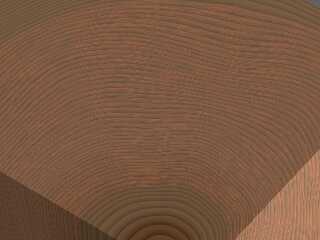
|
 |
|  |
|  |
|
 |
|
 |
|  |




![]()